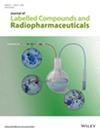Matthew Hird, Joseph J. Russell, Lei Li Corrigan, Istvan Boros, Patrik Nordeman, Gunnar Antoni, Mark Gurnell, Franklin I. Aigbirhio
下载PDF
{"title":"用于肾上腺成像的 PET 放射性示踪剂 [18 F]CETO 在 Synthra RNplus 上的自动放射合成。","authors":"Matthew Hird, Joseph J. Russell, Lei Li Corrigan, Istvan Boros, Patrik Nordeman, Gunnar Antoni, Mark Gurnell, Franklin I. Aigbirhio","doi":"10.1002/jlcr.4078","DOIUrl":null,"url":null,"abstract":"<p>Primary aldosteronism (PA) is the leading secondary cause of hypertension. Determining whether one (unilateral) or both (bilateral) adrenal glands are the source of PA in a patient remains challenging, and yet it is a critical step in the decision whether to recommend potentially curative surgery (adrenalectomy) or lifelong medical therapy (typically requiring multiple drugs). Recently, we have developed a fluorine-18 radiopharmaceutical [<sup>18</sup>F]CETO to permit greater access to PA molecular imaging. Herein, we report an automated synthesis of this radiotracer. To manufacture the radiopharmaceutical routinely for clinical PET studies, we implemented an automated radiosynthesis method on a Synthra RNplus© synthesiser for which Cl-tosyletomidate was used as the precursor for radiolabelling via nucleophilic [<sup>18</sup>F]fluorination. [<sup>18</sup>F]CETO was produced with 35 ± 1% (<i>n</i> = 7), decay corrected and 25 ± 4% (<i>n</i> = 7) non-decay corrected radiochemical yield with molar activities ranging from 150 to 400 GBq/μmol. The GMP compliant manufacturing process produces a sterile formulated [<sup>18</sup>F]CETO injectable solution for human use as demonstrated by the results of quality control. Automation of the radiosynthesis of [<sup>18</sup>F]CETO should facilitate uptake by other adrenal centres and increase access to molecular imaging in PA.</p>","PeriodicalId":16288,"journal":{"name":"Journal of labelled compounds & radiopharmaceuticals","volume":"67 2","pages":"67-75"},"PeriodicalIF":0.9000,"publicationDate":"2023-12-20","publicationTypes":"Journal Article","fieldsOfStudy":null,"isOpenAccess":false,"openAccessPdf":"https://onlinelibrary.wiley.com/doi/epdf/10.1002/jlcr.4078","citationCount":"0","resultStr":"{\"title\":\"Automated radiosynthesis of [18F]CETO, a PET radiotracer for imaging adrenal glands, on Synthra RNplus\",\"authors\":\"Matthew Hird, Joseph J. Russell, Lei Li Corrigan, Istvan Boros, Patrik Nordeman, Gunnar Antoni, Mark Gurnell, Franklin I. Aigbirhio\",\"doi\":\"10.1002/jlcr.4078\",\"DOIUrl\":null,\"url\":null,\"abstract\":\"<p>Primary aldosteronism (PA) is the leading secondary cause of hypertension. Determining whether one (unilateral) or both (bilateral) adrenal glands are the source of PA in a patient remains challenging, and yet it is a critical step in the decision whether to recommend potentially curative surgery (adrenalectomy) or lifelong medical therapy (typically requiring multiple drugs). Recently, we have developed a fluorine-18 radiopharmaceutical [<sup>18</sup>F]CETO to permit greater access to PA molecular imaging. Herein, we report an automated synthesis of this radiotracer. To manufacture the radiopharmaceutical routinely for clinical PET studies, we implemented an automated radiosynthesis method on a Synthra RNplus© synthesiser for which Cl-tosyletomidate was used as the precursor for radiolabelling via nucleophilic [<sup>18</sup>F]fluorination. [<sup>18</sup>F]CETO was produced with 35 ± 1% (<i>n</i> = 7), decay corrected and 25 ± 4% (<i>n</i> = 7) non-decay corrected radiochemical yield with molar activities ranging from 150 to 400 GBq/μmol. The GMP compliant manufacturing process produces a sterile formulated [<sup>18</sup>F]CETO injectable solution for human use as demonstrated by the results of quality control. Automation of the radiosynthesis of [<sup>18</sup>F]CETO should facilitate uptake by other adrenal centres and increase access to molecular imaging in PA.</p>\",\"PeriodicalId\":16288,\"journal\":{\"name\":\"Journal of labelled compounds & radiopharmaceuticals\",\"volume\":\"67 2\",\"pages\":\"67-75\"},\"PeriodicalIF\":0.9000,\"publicationDate\":\"2023-12-20\",\"publicationTypes\":\"Journal Article\",\"fieldsOfStudy\":null,\"isOpenAccess\":false,\"openAccessPdf\":\"https://onlinelibrary.wiley.com/doi/epdf/10.1002/jlcr.4078\",\"citationCount\":\"0\",\"resultStr\":null,\"platform\":\"Semanticscholar\",\"paperid\":null,\"PeriodicalName\":\"Journal of labelled compounds & radiopharmaceuticals\",\"FirstCategoryId\":\"3\",\"ListUrlMain\":\"https://analyticalsciencejournals.onlinelibrary.wiley.com/doi/10.1002/jlcr.4078\",\"RegionNum\":4,\"RegionCategory\":\"医学\",\"ArticlePicture\":[],\"TitleCN\":null,\"AbstractTextCN\":null,\"PMCID\":null,\"EPubDate\":\"\",\"PubModel\":\"\",\"JCR\":\"Q4\",\"JCRName\":\"BIOCHEMICAL RESEARCH METHODS\",\"Score\":null,\"Total\":0}","platform":"Semanticscholar","paperid":null,"PeriodicalName":"Journal of labelled compounds & radiopharmaceuticals","FirstCategoryId":"3","ListUrlMain":"https://analyticalsciencejournals.onlinelibrary.wiley.com/doi/10.1002/jlcr.4078","RegionNum":4,"RegionCategory":"医学","ArticlePicture":[],"TitleCN":null,"AbstractTextCN":null,"PMCID":null,"EPubDate":"","PubModel":"","JCR":"Q4","JCRName":"BIOCHEMICAL RESEARCH METHODS","Score":null,"Total":0}
引用次数: 0
引用
批量引用
![Automated radiosynthesis of [18F]CETO, a PET radiotracer for imaging adrenal glands, on Synthra RNplus](https://img.booksci.cn/booksciimg/2023-12/108321883871792576957.jpg)
![Automated radiosynthesis of [18F]CETO, a PET radiotracer for imaging adrenal glands, on Synthra RNplus](https://img.booksci.cn/booksciimg/2023-12/20231222106435222432.png)
![Automated radiosynthesis of [18F]CETO, a PET radiotracer for imaging adrenal glands, on Synthra RNplus](https://img.booksci.cn/booksciimg/2023-12/96287183481737480302.jpg)

 求助内容:
求助内容: 应助结果提醒方式:
应助结果提醒方式:


